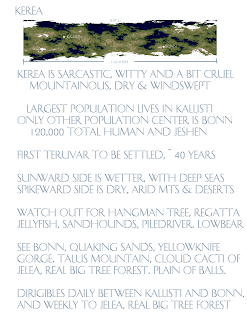Started up my new campaign over IRC on Sundays, replacing our long, long running (since 2003) StarCluster game for the nonce. We are playing Outremer, in 1560 or so. The PC Association is a group of relic hunters, attempting to ascertain whether various relics and artifacts dug up here and there around Outremer are real or fake. the Association was supported clandestinely by representatives of Christian, Muslim, and Jewish religious organizations, for the purposes of curbing fake relics and artifacts. The Association was based in the abandoned Abbey of St. Origen just outside of Tiberias, in the Galilee.
The operatives are Ibrahim, a Sufi Dervish; Rikvah, a Jewish Alchemist; Timur, a half-Djinn, half-Bedu Fakir; and Symeon, a Greek mechanist. There will also be a Kabbalist later on, but the player is away on vacation, and we have not yet met him/her.
We started with quick descriptions of the characters, then Rupert, the Association's Master Librarian, handed over three potential quests, culled from the Association's far-flung web of informants and friends.
From our circle in Antioch came a notice that the cradle of St. Paul had been found in Tarsus, in the Kingdom of Armenia - we had no informants in Armenia at all, and Antioch was the closest group. Now no one was entirely sure Paul had been born in Tarsus, though it was well attested he had been brought up there.
From our informants in Jerusalem came a message that the final grave of Isa (Jesus) had been found by Bedu herdsmen in the Judean hills. This was scandalous, as by either Christian or Muslim tradition, Isa had ascended bodily into heaven, either before (Muslim) or after (Christian) his temporary death.
And from our ring of supporters in Aqaba came word that the Rod of Moses and Aaron had been found near Petra. This would be a major find if true - Moses being a major figure in all three religions.
It was decided that Ibrahim would undertake the long travel to Tarsus, because , as a Dervish, he could simply be there while he was still in Tiberias. Timur was to be sent to Jerusalem to meet with the Bedouin, because , as a half-Djinn, he could get there through the Spirit World quickly, and be back the next day. The rest set out preparing to travel to Aqaba, to see about this Rod of Moshe.
Ibrahim sent part of himself to Tarsus in Arminia, and met with friends of his there, catching up on gossip. He learned among other things that the cradle of Paul had been found by a close relative of the city's Latin bishop, who was promoting the find, and had even commissioned a silver housing for it. The Patriarch thought much less of it, though this was typical of relations between the two. The main support for the legitimacy of the cradle as an artifact was the testimony of a beggar, a Christian Arab named Haroun, who had been cured of leperosy by touching the relic and calling out to St. Paul for intercession.
Ibrahim met with the beggar, who was being properly taken care of by the Bishop at a respectable inn - after all, the man could no longer beg now that he was cured! Using his ability to tell falsehood from truth, he soon ascertained that Haroun had faked the cure, and felt guilty about it. Ibrahim gently brought the beggar about to the conclusion that he should recant his testimony of his 'cure' publicly. Haroun went off to do so, and Ibrahim no longer needed to be there, so that part of him was returned to the Abbey.
Timur traveled quickly through the Spirit World to Jerusalem, meeting with Clara, the correspondent who had alerted them of the Bedu find. She told him what she knew of the tribe, and where they were camped, outside the Hebron Gate. The tribe's Sheik met him, and after some questions on his ancestry - his tribe traveled mostly in Edessa, and was no enemy - welcomed him as a fellow Bedu, inviting him to dinner, where they tried to get his stallion for stud.
Meanwhile, the rest prepared for the trip to Aqaba over land, but Symeon announced he was working on a potential time-saver - a pair of flying carpets which could carry them all to Petra in Aqaba. He had finished one armature and needed time to construct the second, but would be able to finish it so their trip would take one day rather than five.
We stopped there. A good beginning, and a great cast of characters.


